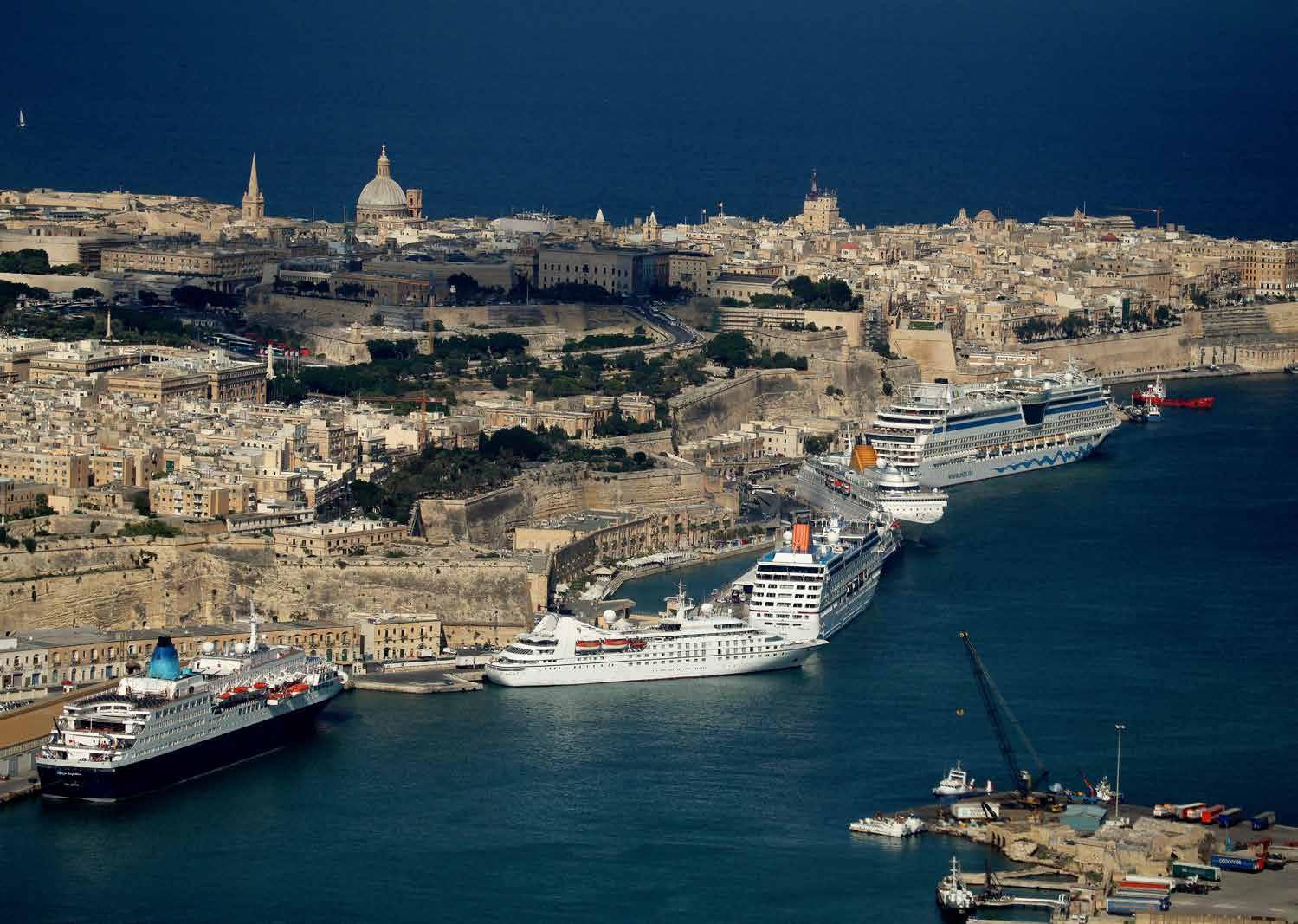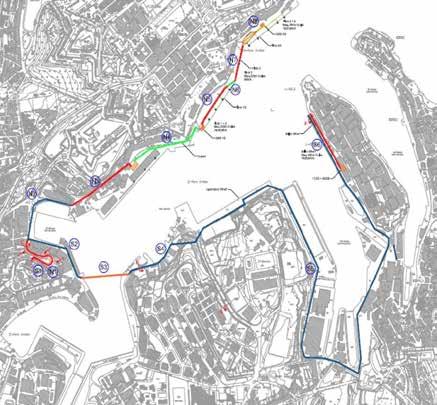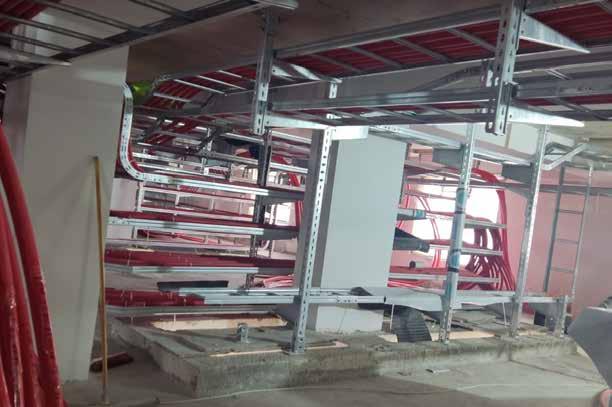
9 minute read
In the News
Special Feature

Advertisement
The Road Towards Clean Ports
Words: Peter Paul Barbara, Norbert Attard, Janice Borg
Back in 2014, as part of a Transport Malta led EU funded project - PORT-PVEV, Transport Malta had commissioned a fully fledged study on the feasibility of the possible introduction of Shore to Ship technology in our Grand Harbour.

Shore to Ship technology is commonly referred to as Cold Ironing. In short, it means that when a vessel is berthing in a given port, it switches off its auxiliary engines onboard, which are used for hospitality purposes and services, and instead takes its energy needs from the electricity grid of the hosting port. This brings the vessel down to zero harmful air pollution emissions in the air, thus considerably reducing air pollution in the area. It is a known fact that the areas surrounding the Grand Harbour have been subject to high levels of air pollution throughout the years, and this has left negative effects on the quality of life in the surrounding maritime towns and villages. This feasibility study was one of the main deliverables of the PORT- PVEV project.
This was a period when the EU Commission was engaging itself in the promotion of sustainable energy modes and infrastructure for different modes of Transport, especially through Directive 2014/94/EU on the deployment of alternative fuels Infrastructure. The technology at the time was still being tested out with a number of units in Scandinavian Ports and a number of others, such as the Port of Hamburg. In that time period, vessels were not equipped to take on this technology, but some were retrofitted for the purpose of pilot projects and testing.
The study, which was commissioned after a competitive tender to E-Cubed Consultants and Cyan Engineering, consisted of an in-depth feasibility study, including the compilation of a baseline, a Cost Benefit Analysis, as well as an Options Analysis.
Since then, a lot has happened, especially in ship technology, and a number of international shipping companies have already started to retrofit the new technology on a number of vessels, while vessels being newly built are equipped with this technology.
Malta has always been a maritime nation, and has a historical dependence on the maritime sector, which historically was brought about by its deep natural harbours and good quality ports. This has served as an incentive to bolster the island to offer services based on its natural and maritime heritage, which would make it even more suited to offer a string of services aimed at international shipping companies, such as bunkering, provision of ship supplies and towage services, ship and yacht repair yards, a state of the art transhipment port and oil terminals, a cruise liner hub and international yacht marinas, just to mention a few.
All of these important economic activities have generated and contributed towards economic growth, but they have also generated negative environmental costs, which at times also leave a considerable negative impact on the health of the population living in the environs of ports.
In addition, the technology will also drastically reduce noise pollution in our ports, thus it will significantly improve the quality of life of residents in the surrounding areas, especially at night.
Fast forward to 2020 and the Infrastructure Malta led Grand Harbour Clean Air Project (GHCAP) came into being, a €49.9 million environmental investment to develop the electrical infrastructure for cruise liners and cargo ships to switch off their gasoil or heavy-fuel-oil fired engines and plug in to shoreside electricity to energise their onboard systems whilst they are berthed at port.
The project kicked off in November 2020. Asked about the timelines of the project, Infrastructure Malta’s target is that by Quarter 2 of 2023 shore connection boxes can be installed, except for Pinto 4 and 5, as work on the extension of the quay has started just now. These are targeted for completion by end 2023. A number of international companies are providing the respective technologies after competitive tenders were published, including Nidec for the supply of the transformers and frequency convertors, ABB for the supply of the switchgear and Cavotec for the mobile connection vessels.
T-21 has asked Transport Malta and Infrastructure Malta’s project managers to give us their thoughts about this important technology-led project, which is set to improve the quality of life of residents living in the affected areas in the years to come.


Norbert Attard Shore-Side Electricity (SSE) in the port of Valletta – A Transport Malta Perspective

Infrastructure Malta is currently engaged in Phase I on the use of Onshore Power Supply (OPS) technology within the Valletta Grand Harbour. Through EU co-financing, OPS will be installed on all the quays on the TEN-T network in the Grand Harbour. The infrastructure will provide OPS to Cruise Liners, Ro-Ro & Ro-Pax vessels. The Valletta Cruise Port Terminal is dedicated to cruise liners and provides all related services. The Valletta Gateway Terminal, on the other hand, is dedicated to cargo operations, including Ro-Ro & Ro-Pax vessels. Boiler Wharf will be entirely equipped with OPS, thus adding to the services currently being offered.
Through this investment, cruise liners and cargo vessels will be able to plug in to OPS whilst at berth, rather than using their auxiliary engines. By disengaging their auxiliary engines, vessels calling at the port of Valletta will emit 93% less nitrogen dioxide, 92.6% less particulate matter, and 99.6% less sulphur dioxide.
These pollutants are among the principal causes of respiratory illnesses, diseases, and other health related problems. The use of this technology will also reduce 39.6% of the cruise liners’ carbon dioxide emissions, which contribute to climate change.
Utilisation of OPS is subject to ship to shore compatibility; however, the Cruise Liner Industry is already in the process of adopting these new systems with some of the current fleet of cruise liners calling in Malta already equipped accordingly, which will allow for the use of the OPS with its direct advantages.
The project for OPS in the North part of the Grand Harbour is on schedule, and commissioning is estimated to commence in Q2 of 2023. The contract of Phase l amounted to an investment of €33.2 million and will be completed by 2025.
Malta is committed to further invest towards OPS by providing these facilities to additional quays within the Grand Harbour, which will form part of Phase II of the operation. These will predominantly provide OPS to the inner areas of the harbour, the South side of the Port as well as additional quays on the outer area. Essentially, this is an investment of €81 million. Phase II is expected to be completed by 2025.
By connecting to OPS, vessels will not be required to run their internal generators, which would normally provide the necessary power for the vessels’ onboard operations. With OPS being a silent system, noise pollution within the Grand Harbour will be considerably reduced in line with social responsibilities towards the reduction of emissions and noise.



Shore Ship Connection Box (Approx Position)
Culverts to be Constructed by Third Parties
Cables Supported on Steel Framework
Cables in Existing Culvert Cables in Trench
Submarine Cable Crossing Cables in Proposed Culvert
• Phase 1 commissioning Q2 2023
• Pinto 1 & 2 – vessels up to an LOA of 330m – 16-20MVA
• Pinto 3 – vessels up to an LOA of 200m – 6 MVA
• Pinto 4 & 5 – vessels up to an LOA of 330m – 16-20MVA
• Deep Water Quay 3 & 4 – vessels up to an LOA of 330m – 16-20MVA
• 4 Cavotec AMP shared alongside the quay
• Boiler wharf - vessels up to an LOA of 330m – 16-20MVA
• 1 Cavotec AMP alongside the quays Phase II
• Phase 2 includes the commissioning of Q4 in 2023
• Ras Ħanżir, Laboratory & Magazine wharf –
HVSC RoRo – 11kV/6.6kV (6.5MVA), LVSC – 1MVA– All LV 400V/440V/690V - 2 Ro-Ro mobile cable management unit
• Palumbo – HVSC cruise – 11kV/6.6kV : Dock 6 – (10MVA) – Parlatorio (5MVA) HVSC Container – 6.6kV : Dock 6 – (7.5MVA) – Parlatorio (5MVA), LVSC – 2000A: Dock 6 – Parlatorio with combined peak amperage of 2000°, 1
Ro-Ro mobile cable management unit, Cruise/
Vessels (special size for Dock 6), 1 mobile cable extension reel for Containers/Vessels.
• Lascaris LVSC – 345kVA : All LV: 400V/440V/690V, 1 Ro-Ro mobile cable management unit
• MMH LVSC - – 345kVA : 3no. All LV: 400V/440V/690V, 14 Mobile Frequency
Converter Unit. Furthermore, two quays within the Malta Freeport Terminal, namely North Quay Terminal 1 (NQT1) and North Quay Terminal 2 (NQT2) will both be provided with a bi-directional High Voltage Shore Connection (HVSC) system for use by container ships whilst at berth.

These two quays are intensely used, especially by the largest container vessels berthing in the Port. The HVSC systems will permit berthed container vessels to switch off ship-board generators producing electrical power and to import and/or export the necessary electrical power to or from the national grid. The power transfer shall be carried out in conformity to international and national standards for container ships. Each system should be able to deliver an aggregate total of 7.5MVA at 6.6kV at 60Hz to the berthed vessels. Likewise, each system should be able to handle an aggregate total power of 7.5MVA supplied by the berthed vessels to the national grid.
The SSE for the HVSC system shall be sourced from the national grid at the Enemalta Freeport Distribution Centre, at 33kV and at a frequency of 50Hz. Correspondingly, ship-to-shore power shall be delivered to the national grid at the same point at the Enemalta Freeport Distribution Centre.
NQT1 shall have 3 fixed shore connection boxes, whilst a mobile cable management system, covering 200m of quay, shall be installed on NQT2. The construction of the first phase of the project is scheduled for the last quarter of this year. It is expected that the HVSC system will be operational by not later than 2025.
Shore-Side Electricity supply for the maritime ports on the TEN-T comprehensive network will be mandatory in 2030. Nonetheless, it must be noted that Malta will be ahead of the Commission’s deadline of 1st January 2030 to implement the technology, and will provide shore-side electricity supply as stipulated in the Alternative Fuels Infrastructure Regulation by 2025, 5 years ahead of schedule.






